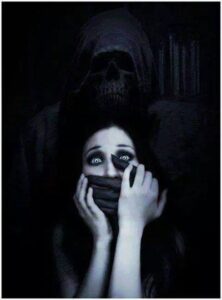The history of La Mala Hora dates back to the 16th century when the concept of the monstress first appeared in Mexico. The monstress was a woman who was said to be cursed and possessed by evil spirits. She was often seen as a danger to society and was often persecuted by the authorities. Over time, the concept of the monstress evolved and she became a more positive figure in Mexican culture. She was seen as a protector of the poor and oppressed, and her legend grew. Today, La Mala Hora is one of the most famous monstresses in Mexico and is revered by many.
The Origins of La Mala Hora:

The origin story of La Mala Hora is a bit of a mystery, as it is a story that has been passed down through generations and has been distorted and changed along the way. However, there are some things that are consistent throughout the legend. One version of the legend states that Mala Hora was born from a powerful Inca chieftain and a goddess from the underworld. It is said that she had special powers that allowed her to protect the oppressed and the poor and to fight for justice. Another version states that Mala Hora was born in death and came back to life again in the form of a monstress. It is believed that she was cursed by a powerful sorcerer and was given special powers to protect the oppressed and the poor. Regardless of which version of the legend you believe, Mala Hora remains one of the most popular and recognizable figures in Mexican culture today. Her legacy persists, and she continues to be seen as a figure of strength and protection.
The Spread of Mala Hora:
The legend of La Mala Hora has persisted and spread across much of Mexico, becoming an integral part of the culture. From Mexico City to small villages in the depths of the jungles, it is said that Mala Hora can be seen at night, patrolling the outskirts of towns, protecting them from evil spirits. In many regions, Mala Hora is revered as a kind of local deity. Locals make offerings to her and build temples in her honor in various places. In some areas, small festivals are held to celebrate her and to show reverence to her. Interestingly, there are many Mexican immigrants who have brought the legend of Mala Hora with them to the United States, where it has slowly but surely spread throughout the years. In many Spanish-speaking areas, parents use the story of Mala Hora to scare their children into behaving, much like a bogeyman. This is a testament to the enduring legacy of Mala Hora and her powerful presence in the culture of Mexico. Though centuries have gone by since her origin story first began circulating, Mala Hora remains an integral part of the culture today.
The Modern La Mala Hora Movement:
In recent years, a new movement has emerged in Mexico to increase public awareness of Mala Hora and her legacy. This movement has been driven primarily by university students, who are actively trying to preserve the legacy of Mala Hora and protect it from potential historical erasure. At the same time, this new movement is working to create an arguably happier narrative in which Mala Hora is venerated rather than feared. This is a major change from the past, in which La Mala Hora was largely feared and seen as an ominous figure. In addition to raising public awareness, this new movement is working towards a reimagined vision of Mala Hora focused on female empowerment and respect for female strength. This is a far cry from the traditional version of Mala Hora, which depicted her as a villainous figure. By advocating for a positive, empowering vision of Mala Hora, this modern movement is helping to bring her story out of the shadows and into the public light. Whether or not this movement will succeed remains to be seen, but it is a welcome new development for La Mala Hora’s legacy.
The Impact of Mala Hora:
The history of Mala Hora dates back to the 16th century when the concept of the monstress first appeared in Mexico. The monstress was a woman who was said to be cursed and possessed by evil spirits. She was often seen as a danger to society and was often persecuted by the authorities. Over time, the concept of the monstress evolved and she became a more positive figure in Mexican culture. She was seen as a protector of the poor and oppressed, and her legend grew. The impact of La Mala Hora in modern Mexican culture has been profound. She has become a symbol of female strength, power, and fearlessness. Many young women look to her as a role model, citing her example as proof that it is possible to face adversity and overcome. At the same time, Mala Hora has also become an example of solidarity amongst women. Her struggle against oppression and injustice is one that resonates with many Mexican women, and her legacy has been taken up by feminists and women’s rights activists. Furthermore, Mala Hora has also become a source of inspiration for artistic pursuits. From musicians to filmmakers, she is used as a motivator to create works that express the struggles of marginalised communities. Indeed, she is often used as a way to empower those who are overlooked and marginalised, to give them an opportunity to express themselves and fight back. In conclusion, Mala Hora’s influence in Mexican culture cannot be overstated. Her legacy of female strength and courage has emboldened women across the country and continues to inspire people to fight for a better world.

















































